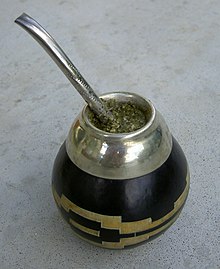Tereré
This article needs additional citations for verification. (September 2007) |


Tereré (of Guaraní origin[1]) is an infusion of yerba mate (in Spanish) / erva-mate (in Portuguese), similar to mate but prepared with cold water rather than with hot,[2] and in a slightly larger vessel. It is originally from Paraguay,[3] and is found also in northeastern Argentina and southern and western Brazil. When hot (mate), the Guaraní people call this infusion ka'ay,[4] where ka'a means herb and y means water.
The vast majority of people in Paraguay take their tereré with water infused herbs such as mint "menta-i" or lemongrass. When not prepared with plain cold water, citrus fruit juices are usually used, although this practice varies depending on the region. While mixing fruit juices with tereré is common in northeastern Argentina, Brazil and Paraguay. Lime and orange juices are used in Argentina and Paraguay; lime and pineapple juice are more common in Brazil. Tereré taken with juice is commonly called "tereré ruso" (i.e., Russian Tereré) because this practice is more common with Slavic immigrants in the southeast of Paraguay and northeast of Argentina, than with Spanish- and Guaraní-speaking Paraguayan people.
In some parts of Argentina, Tereré is seen as a lesser form of mate, and its drinking hardly ever follows the traditional drinking mate ritual. In Paraguay, by contrast, tereré is considered preferable to mate on a hot day.
First invented by the Guaraní (Guarani, in Portuguese language) natives who lived in Paraguay and western Brazil (Mato Grosso do Sul), tereré was spread by the dwellers of that region, and for centuries was a social beverage. People usually prepare one jar of natural water and a "cuia" (Portuguese) / "guampa" (Spanish) with a "bomba" (Portuguese) / "bombilla" (Spanish) which is shared among the group of people. Since Paraguay and Mato Grosso do Sul have a very hot climate, this drink is excellent to refresh the body and can be considered a very low-calorie, non-alcoholic beverage. Additionally, it is an important ritual signifying trust and communion.
Cuias/Guampas are gourds that can be made from animal horns, usually made from ox horns. The new cuia or the one not used for some time needs to be watered before use, because the lower part of the cuia is usually capped with a round piece of leather. By filling the cuia with water the leather expands, covering all leaks in the cuia. Many cuias are capped using a wooden cork as well. Cuias are also made from wood and covered in leather or steel. In a pinch a simple drinking cup can serve as a cuia.
Bombas/Bombillas are metal straws with a filter at the end. Erva-mate/Yerba is placed at the bottom of the cuia, and as water is added the bomba drinks from the cuia the clear green liquid.
Tereré in Paraguay, tererê in Brazil
Tereré is a typical drink from Paraguay. It is very popular among young and old people. It is common to see students going to school with a guampa and their thermos underneath their arms filled with plenty of ice and water, for summer temperatures can reach 40° to 45°C (104° to 113°F).
Workers used to have a "tereré break" instead of a coffee break. In most workplaces, tereré is allowed among other things because the yerba mate has stimulant effects that can be likened to the role of coffee in an American workplace.
As a popular remedy, the people of Paraguay heal various ailments such as headache, stomachache, and diarrhea by adding medicinal herbs into the water.
The act of drinking Tereré is more than just that, however. It is often used as a reason to share and chat with a partner, meet new people, or just for meditation when drinking alone at the end of the day.
See also
References
This article needs additional citations for verification. (January 2011) |
